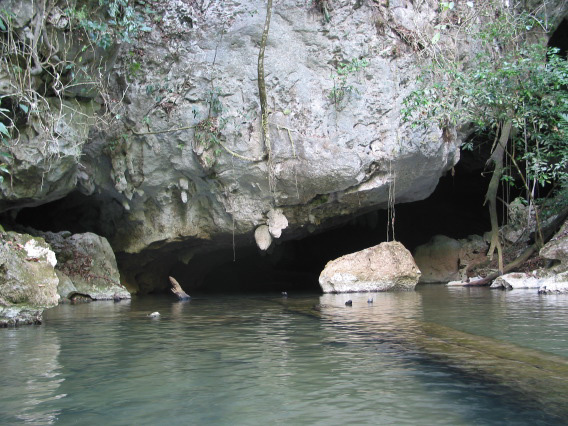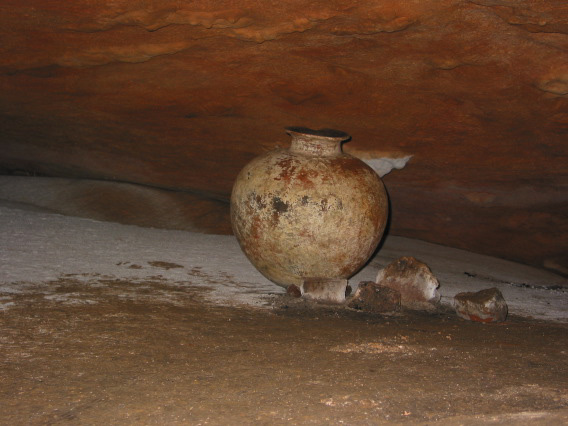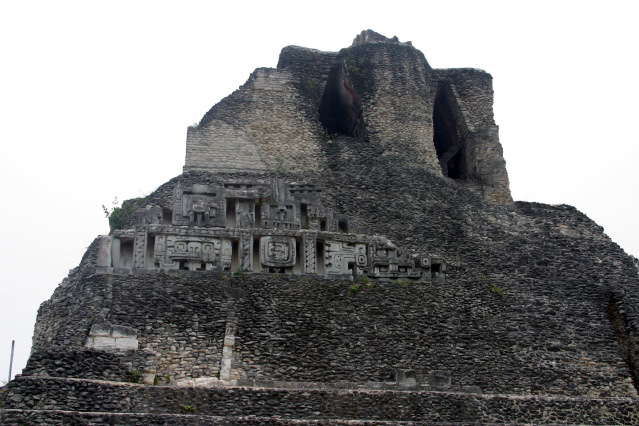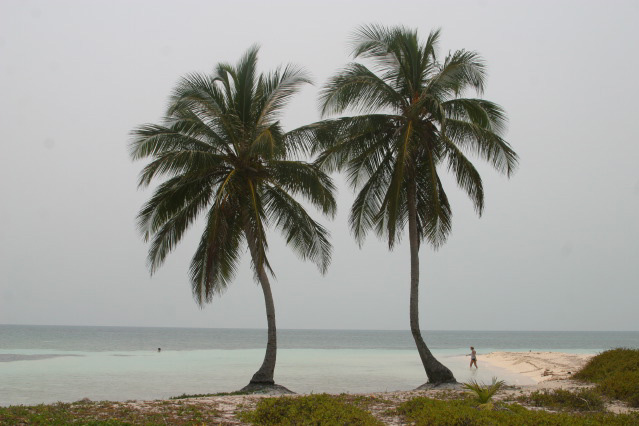Travels in Geology January 2006
Belize: The ins and outs
 Following a busy hurricane season, reports of ravaged resorts and washed away
beaches may deter you from heading to Mexico's Gulf Coast. But before giving
up hope for a midwinter respite, don't forget to consider the unscathed countries
farther south. A week or two of exploring Belize's inland jungle caves and
Maya ruins will please adventurers, while Belize's cayes (islands), just off
the coast, will satisfy snorkelers, divers and beach loungers.
Following a busy hurricane season, reports of ravaged resorts and washed away
beaches may deter you from heading to Mexico's Gulf Coast. But before giving
up hope for a midwinter respite, don't forget to consider the unscathed countries
farther south. A week or two of exploring Belize's inland jungle caves and
Maya ruins will please adventurers, while Belize's cayes (islands), just off
the coast, will satisfy snorkelers, divers and beach loungers.
River Cave is
one of many caves within the jungles of Belize. Beneath the overhang shown
here is the only entrance and exit for tourists who wish to see the cave formations
and Maya artifacts inside. All images courtesy of Ben Babusis, Lightscape
Gallery.
The best time to visit Belize's islands or mainland is during high season (also
the dry and warm season), which runs from the end of November through April.
Keep in mind, however, that Christmas, New Year's Day, Good Friday, and Easter
Sunday are official holidays observed in Belize. Airline tickets might be more
expensive around these dates, and transportation and services in Belize could
be difficult to come by.
Most travelers fly into Phillip S.W. Goldson International Airport, which
can be reached via direct flights from Miami. From here you can rent a car or
take a taxi to Belize City or to the capital city Belmopan, from which you can
find any number of tour groups that will take you into the jungle.
One such group is the Caves Branch Jungle Lodge, a mere 19
kilometers south of Belmopan and located on privately owned 58,000 acres of
pristine jungle. Once here, you will not find much reason to leave. Experienced
guides can take you on tours that include caving, mountain biking, kayaking,
diving and snorkeling, as well as outings to explore Maya ruins.
A Maya pot is
precariously perched inside River Cave in Belize. Found in one piece almost 18
years ago at the same time that the cave was discovered, it likely transported
water and food.
Caves and sinkholes at Caves Branch formed over thousands of years, as the
Caves Branch River and acidic rain carved away the limestone. Archaeologists
have found Maya artifacts in many of the caves, which they think were used for
the culture's rituals, including sacrifices. Look for pottery shards and pieces
of human remains as you maneuver around stalagmites and stalactites of River
Cave, and use ropes to climb the waterfalls (and get soaking wet) in Waterfall
Cave. Just be certain that you don't touch any formations — oil from your skin
will kill formations, some of which grow as slowly as a tenth of a millimeter
per year.
Tours from Caves Branch also provide transportation to Maya ruins throughout
the country, such as Xuanantunich and Cahal Pech. Climb through the excavated
temples or visit a Maya "ball court," a site where Maya priests would
compete to kick a ball through a small vertical hoop, similar to a cross between
modern soccer and basketball. Unlike today, however, the "winner" of
this game would be sacrificed, which the Maya viewed as an honor and a quicker
way to ascend the nine levels of the afterlife.
This 40-meter-tall
Maya temple is located within the Xuanantunich ruins in Belize. The Caves
Branch Jungle Lodge offers tours of this site, as well as many others.
The jungle can become oven-like, however, with the hottest days reaching 42
degrees Celsius (108 degrees Fahrenheit) with high humidity. For a break from
the heat, take Maya Island Air to any of the cayes, located between Belize's
mainland and the barrier reef, and relax in the cool tropical breezes.
 Palm trees grow on a
desolate island near Ambergris Caye. Cooler temperatures and sandy beaches are
a stark contrast to the humid jungle of inland Belize, and are only a short
flight away from Belize City.
Palm trees grow on a
desolate island near Ambergris Caye. Cooler temperatures and sandy beaches are
a stark contrast to the humid jungle of inland Belize, and are only a short
flight away from Belize City.
The largest of the islands, Ambergris Caye, boasts a wide selection of hotels and restaurants. While visiting Ambergris, schedule a short boat trip out to Shark-Ray Alley. Friendly sharks and rays still gather here, which used to be the site where fishermen would dispose of fishing waste. Don't let the fearsome look of the nurse sharks keep you from taking a snorkel or a dive to feel their sandpaper-like skin — fish, not humans, are their preferred food.
Kathryn Hansen
Links:
Caves
Branch Adventure Co. & Jungle Lodge
Ambergris
Caye.com
Frommer's,
Belize
Travels in Geology

